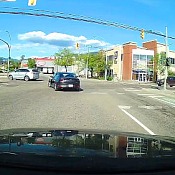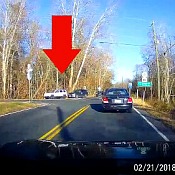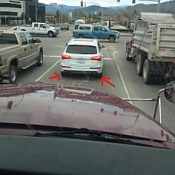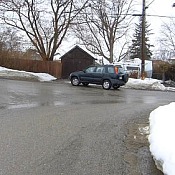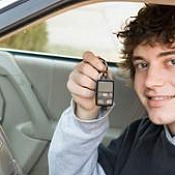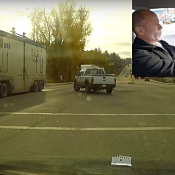Most cities are going to have multiple turning lanes. Get the right information here.
How to Use Multiple Turning Lanes Correctly
Introduction
Hi there smart drivers.
Have you ever had this happen to you?
See that!
There's a perfect example.
Yes! Being cut off on a multi-lane turn or having other vehicles deviate out of their lane.
That's what we're going to talk about today.

How to do multi-lane turn safely, and for the purposes of passing a road test.
Stick around, we'll be right back with that information.
[INTRO & UPBEAT MUSIC] Hi there smart drivers.
Welcome back.
Turning in Cities Using Multiple Turning Lanes
Rick with Smart Drive Test talking to you today about how to do multi-lane turns, both for passing a road test and to stay safe.
Now if you're new to Smart Drive Test, Smart Drive Test helps new drivers get a license, veteran drivers to remain crash free, and CDL drivers to start a career as a truck or bus driver.
So if you're new here, consider subscribing.
Hit that subscribe button... just about there.

As well, hit that bell, that way you'll get instant notification when I get the videos up for you.
So I'm going hook up the cameras here and go for a drive and show you how to do multi-lane turns, both for passing a road test and staying safe.
Stay in the Right Lane When Turning Left
We're approaching a multi-lane left-hand turn.
We make the right here.
We have our own lane.
We get around the corner.
So we just proceed into our own lane making sure that there aren't other vehicles moving over into our lane, like the one that's straddling the lane in front of us.
Left signal on, shoulder checking, and I can see the overhead signs indicating lane designation.

And I'm moving into the outside lane because that way on the left-hand turn when I get around the corner I'm going to be in the right-hand lane.
And therefore I don't have to change lanes around the corner.
Remember to keep two hands on the steering wheel.
Keep your signal.
Position your vehicle so you can see the tires of the vehicle in front of you making clear contact with the pavement.
Both hands on the steering wheel.
This is actually a fairly simple intersection because there are lane markings.
And you can see the lane markings all the way through the intersection.
As well you want to use the traffic on the inside here as a guide of where you're going to go through the intersection.
You can also see the gravel and the tracks through the intersection.

So have a look at that as you're moving through the intersection.
Now just keep in mind, this white car in front of us was the car that was straddling lanes.
And the driver wasn't really sure where they're going, so I'm going to keep my distance from this white car in front of me knowing that information.
So we're just waiting.
This is a fairly long light because it's a big intersection.
[TRANSITION] And we're proceeding through the intersection.
You can see the line on the left there and we head through the intersection nice and slow, keeping the traffic out to the outside.
And we can see the 50kph (30mph) sign.

And we're gonna stay at 50 kilometers an hour (30mph).
And we can also see the big trucks up ahead here on the hill climbing the hill.
And we can see that the flat deck is going fairly slow here so I'm not going to get too quick here.
Also you can see the Jeep is doing something weird here and the pickup truck is right up on the back of the Jeep.
So I'm just want to stay away from that because maybe the Jeep's lost.
Monitor What Other Driver's Are Doing When Turning With Multiple Lanes
Two turning lanes to the left here.
And changing lanes over to the lane that I need to get into to get into the turning lanes.

This time I'm going to take the outside turning lane and this is what you want to do for the purposes of your road test is get in the outside turning lane when you're turning left.
That way when you get around the corner you're going to be in the right-hand lane.
And that's the lane that you want to travel in for the purposes of a road test.
It's also a good defensive move because any time that you don't have to change lanes is obviously safer than changing lanes and risking that transition.
So we come up, stop at the stop line.
And obviously it's going to take a little bit.
Now here I want to aim for the outside.

Look for Landmarks When You're Waiting
So you can see in dashcam there, you can see the gravel on the road.
You want to stay near that gravel on the right-hand side of the vehicle.
As well, there's a a sewer cover over on the other side there.
I want to aim for that sewer cover.
So you can see the tracks in the intersection where the vehicles travel.
And you want to stay away from the vehicle on my left here.
And essentially, that's one of your markers for the purposes of doing a left-hand turn.
So we're going here and we're driving straight into the intersection and then turning and we're lining up with our...see that!

There's a perfect example.
That person just cut the lane right off in front of me.
And had I not stayed out, that person would have taken my front end off.
So that was excellent.
Shoulder Check, Shoulder Check, Shoulder Check
[CHUCKLING] That couldn't have been better ever! And that's the reason why you should shoulder check and stay out to the to the right when you're doing those turns.
That was... that was absolutely perfect.
So we're approaching an intersection.
It's a T-intersection that has two right-hand turning lanes.
And I'm going to move over to the left lane here because there's signs indicating that large vehicles, trucks, buses and RV units need to be in the left-hand lane to turn right at this intersection.

Because if you're not in the correct lane at this intersection and you're driving a larger vehicle what's going to happen is you're going to get shoved up against a fixed object and you're not going to get around the corner successfully or you're going to run into other vehicles.
Signs Prohibiting Turns on Red Lights
So that's the reason that buses and trucks and large vehicles are prohibited from being in the right-hand lane at this intersection.
You can see the road markings: they're clearly marked here.
You can see the solid white lines which means that you're not allowed to change lanes at the intersection.
As well, you can see the signs here at the intersection prohibiting right-hand turns on a red light.
And you can see the lane designation signs showing which lanes go around.
And also, there's a left-hand turning lane here.
Because as I said it's a T-intersection.

So we just proceed and we stay right out to the left.
Use the left lane markings as our guide to go around the corner.
We shoulder check and make sure that nobody's coming into our lane.
And then we simply move back over to the right.
Because we're going travel in the right hand lane now.
Turning Left From the Inside Lane
And again, there's two left turning lanes here.
We're going to take the inside one on this one.
We're on the inside this time.
And we're coming up.

And again, we can just see the lines here.
A lot of the lines have disappeared here owing the fact that it's springtime.
In the winter the dirt and gravel and whatnot wears the lines out.
They're getting around to repainting them.
Road Markings are Worn Off in the Spring
Again as you're sitting here waiting for the light to change, we're looking over there to see where our destination is.
We want the front left corner of the vehicle to just go on the inside of that concrete median over there.
So we're watching the light.
It's ready to change here.
And vehicles are stopped.
And we go.
And there's no vehicles here.
You can see that I shoulder checked.
And again we just stay to the inside here.
And we follow... still steering the vehicle.
The vehicle's straight and we get it going.

And we get up to speed and we travel in the right hand lane.
Shoulder check again before we enter the other lane.
Signal on the entire time that you're changing lanes.
Cancel your signal and proceed.
If In Doubt, Follow the Other Traffic
[TRANSITION] So you can see the solid white lines here.
This means you need to get into the turning lane as soon as it starts back there.
And you can't change lanes.
You can't deviate once you get into the lane.
Once you get into the lane, you're committed.
Okay and we're in the outside lane here.
You can see the roadway's got lots of ruts.
That's because there's big trucks that make the turn here.

And then we just wait again.
And here you can follow the other traffic.
You can use the other traffic as a guide of where to travel through the intersection.
But here you want to travel out... probably to the middle lane here because there's another lane here and there's three lanes of traffic over there.
But I'll know better once I get into the intersection, where I want to go on the other side.
But I know also that I can use this traffic on my left as a guide.
Don't Turn Beside Other Vehicles - Stay in Front or Behind
And as long as I maintain that sort of four to five feet away from that traffic then I'm gonna be okay going through the intersection.
Ready to go.
And we're watching the other traffic.
Actually this one's got a line, so it's very easy on this one.
You just stay right of the line and just follow it around nice and easy.
Looking down the road and then watching those vehicles to your left.

And exactly what that other vehicle did and that other lane change making sure they're not coming across and again you always want to drive into spaces between the vehicles.
Especially when they don't shoulder check, like that.
So know that drivers are going start moving and then they're going to look.
So driving in Kelowna, British Columbia, Canada is is a bit more challenging than [LAUGHING] in Vernon.
And some of you are going like this because it's a lot busier for you and this is going to give you better indication of how to deal with other drivers who are driving goofy.
Turning Left at a Major Intersection
[TRANSITION] One more turning lane.
Turning to the left and we're going to get in the outside lane.
And we're at the back of the queue.

And you see the arrows on the roadway.
There aren't any overhead signs here.
And again we're going to use the traffic on our left as an indicator of where we stay in our lane.
You can see the green arrow up there has gone to green.
And we're ready to go.
And we're following the traffic.
We're following the traffic.
We're staying off here.
And you can see the gravel in the centre of the intersection.
That's your marker in the center.
And right into the center lane.

And then we accelerate and proceed.
And you can see there in some of the turns today we had some challenges with other drivers cutting us off, but we did all right.
And that's how you make turns on multi-lane roads and do it safely and do it for the purposes of a road test.
I'm Rick with Smart Drive Test.
Thanks very much for watching.
Good luck on your road test.
And remember, pick the best answer not necessarily the right answer.
Have a great day.
Bye now.
Blooper
[TRANSITION] And I forgot to turn the defrost down yet again.

Because it is cold this morning and I'm wearing a T-shirt in the car to try and match the shirt I was wearing when I filmed this several months ago.
So that's what I'm doing.
And so I forgot to turn the defrost down and I've turned it off now and you can hear me... so

